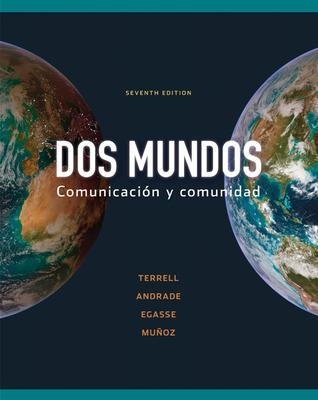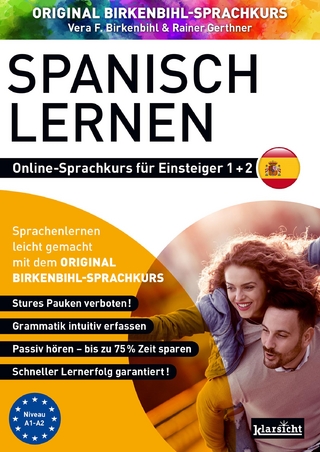
Audio CD Part B t/a Dos mundos
McGraw-Hill Inc.,US (Verlag)
978-0-07-730478-2 (ISBN)
Tracy D. Terrell (late) received his Ph.D. in Spanish Linguistics from the University of Texas at Austin and published extensively in the area of Spanish dialectology. Professor Terrell’s publications on second-language acquisition are widely known in the United States and abroad. Magdalena Andrade received her first BA in Spanish and French and a second BA in English from California State University, San Diego. After teaching in the Calexico Unified School District Bilingual Program for several years, she taught elementary and intermediate Spanish at both San Diego State and the University of California, Irvine, where she also taught Spanish for Heritage Speakers and Humanities Core Courses. Upon receiving her PhD from the University of California, Irvine, she continued to teach there for several years and also at the University of California, Riverside, and California State University, Long Beach, where she taught the graduate foreign language methods courses and coordinated the Spanish and French TA Programs as well as the Credential Program for foreign languages. For several years she has taught at the community college level, but currently, she is taking time off from regular teaching to help dyslexic children hone their reading skills. She also tutors special-needs students taking college-level Spanish courses. Professor Andrade has coauthored the textbook Dos mundos: Comunicación y comunidad and the readers Mundos de fantasía: Fábulas, cuentos de hadas y leyendas and Cocina y comidas hispanas (McGraw Hill). Jeanne Egasse received her BA and MA in Spanish Linguistics from the University of California, Irvine. She also holds California Credentials for Spanish as well as for Bilingual Cross-Cultural Education. Professor Egasse has taught foreign-language methodology courses and introductory linguistics, and served as supervisor of foreign language and ESL teachers in training for the Department of Education at the University of California, Irvine. From 1980 to 2020 she was a full-time professor of Spanish, coordinator of the Spanish Department, and co-chair of World Languages at Irvine Valley College. Professor Egasse continues to offer online conversation groups for local college students and volunteers for the Irvine Valley College Foundation. In addition, she serves as a consultant for local schools and colleges on implementing the Natural Approach in the language classroom. She has coauthored the first-year college Spanish textbook Dos mundos: Comunicación y comunidad and the readers Cocina y comidas hispanas and Mundos de fantasía: Fábulas, cuentos de hadas y leyendas (McGraw Hill).
(Note: The preliminary chapters (Paso A-C) and Capítulo 1 of this Table of Contents provide a comprehensive listing of contents for those chapters, as representative of the other chapters. Capítulo 2-15 provides only the vocabulary topics and grammatical structures.)
The following lists the Enlace readings found in each chapter:Capítulo 1 Enlace a la música • CubaCapítulo 2 Enlace a la música • La música andina Capítulo 3 Enlace al cine • México y España Capítulo 4 Enlace a la literatura • “Versos sencillos” José MartíCapítulo 5 Enlace a la música • El rock en españolCapítulo 6 Enlace a la literatura • “Cuadrados y ángulos” Alfonsina Storni Capítulo 7 Enlace a la literatura • “Cuando salimos de El Salvador” Jorge ArguetaCapítulo 8 Enlace a la literatura • “Jitomates risueños” Francisco X. AlarcónCapítulo 9 Enlace a la música • La música infantilCapítulo 10 Enlace a la literatura • “Dos cuerpos” Octavio PazCapítulo 11 Enlace a la música • La danza negra en PerúCapítulo 12 Enlace al cine • Argentina y Chile Capítulo 13 Enlace a la literatura • “Nada más” María Elena WalshCapítulo 14 Enlace a la literatura • “Kinsey Report No.6” Rosario CastellanosCapítulo 15 Enlace a la literatura • “La noche buena” Tomás Rivera
Paso A La clase y los estudiantes Actividades de comunicaciónLos nombres de los compañeros de clase¿Quién es? Los colores y la ropaLos números (0–39) Los saludosGramáticaA.1 Naming and Describing: The Verbs llamar and llevarA.2 Spelling: The Spanish AlphabetA.3 Identifying People and Things: Subject Pronouns and the Verb ser A.4 Identifying People and Things: GenderA.5 Responding to Instructions:Commands Paso B Las descripciones Actividades de comunicaciónHablando con otrosLas cosas en el salón de claseLos números (40–69) El cuerpo humanoLa descripción de las personasGramáticaB.1 Addressing Others: Informal and Polite you (tú/usted)B.2 Expressing Existence: hay B.3 Describing People and Things:NegationB.4 Describing People and Things: Plural Forms B.5 Describing People and Things: Adjective-Noun Agreementand PlacementPaso C Mi familia y mis amigos Actividades de comunicaciónLa familia¿Qué tenemos? Los números (10–100) y la edadLos idiomas y las nacionalidadesGramática C.1 Expressing Possession: The Verbs tener and ser de (l) C.2 Expressing Possession: Possessive Adjectives C.3 Expressing Age: The Verb tener C.4 Describing People: Adjectives of Nationality C.5 Talking about Habitual Actions: Present Tense of Regular –ar VerbsCapítulo 1 Los datos personales y las actividadesActividades de comunicación y lecturasLas fechas y los cumpleañosDatos personales: El teléfono y la dirección Ventanas culturales • Nuestra comunidad: Rigoberta MenchúEnlace a la música • CubaLa horaLas actividades favoritas y los deportesVentanas al pasado • Diego Rivera y Frida KahloEn resumenLectura: La pasión por los deportesGramática1.1 Counting: Numbers 100–1000 and Dates 1.2 Talking about Habitual Actions: Present Tense of –er and –ir Verbs1.3 Asking Questions: Question Formation 1.4 Telling Time: Hours and Minutes 1.5 Expressing Likes and Dislikes: gustar + Infinitive Capítulo 2 Mis planes y preferencias Actividades de comunicaciónLos planesLas clasesLas preferencias y los deseosEl tiempoGramática2.1 Expressing Future Plans: ir + a + Infinitive 2.2 Sequencing: Ordinal Adjectives 2.3 Stating Preferences and Desires: preferir and querer + Infinitive 2.4 Describing the Weather: Common Expressions2.5 Pointing Out People and Objects: Demonstrative AdjectivesCapítulo 3 Los lugares y las actividades Actividades de comunicaciónLas actividades diariasLas tres comidasLos lugares¿De dónde es usted? Gramática3.1 Talking about Habitual Actions: Present Tense of Regular Verbs3.2 Using Irregular Verbs: haver, salir, jugar3.3 Referring to Objects Already Mentioned: Direct Object Pronouns lo, la, los, and las3.4 Asking and Answering Questions3.5 Talking About Location and Origin: estar + en, ir + al / a la and ser deCapítulo 4 La vida diaria y los días feriadosActividades de comunicaciónLos dias feriados y las celebracionesLa rutina diariaLos estados físicos y anímicos Gramática 4.1 Discussing Habitual Actions: Verbs with Stem-Vowel Changes (ie, ue) in the Present Tense 4.2 Discussing Habitual Actions: Irregular Verbs 4.3 Describing Daily Routine: Reflexives 4.4 Ordering Events: Infinitives after Prepositions 4.5 Describing States: estar + Adjective and tener + Noun Capítulo 5 Las clases y el trabajo Actividades de comunicaciónLas actividades de la clase de españolLas habilidadesLas carreras y las actividades del trabajoLas actividades futurasGramática 5.1 Indicating to Whom Something is Said: Indirect Object Pronouns with Verbs of Informing 5.2 Expressing Abilities: saber and poder + Infinitive5.3 Referring to Actions in Progress: Present Progressive 5.4 Expressing Obligation and Duty: tener que, deber, necesitar, hay que, es necesario 5.5 Expressing Plans and Desires: pensar, quisiera, me gustaría, tener ganas de Capítulo 6 La residencia Actividades de comunicaciónEl vecindario y la casaLas actividades en casaLas actividades con los amigosLas presentacionesGramática 6.1 Making Comparisons of Inequality: más/menos 6.2 Making Comparisons of Equality: tan/tanto 6.3 Talking about Past Actions: Preterite Tense of Regular Verbs (Part 1) 6.4 Knowing People, Places, and Facts: conocer and saber 6.5 Referring to People Already Mentioned: Personal Direct Object Pronouns Capítulo 7 Hablando del pasado Actividades de comunicaciónMis experienciasLas experiencias con los demásHablando del pasadoGramática 7.1 Talking About Past Actions:Preterite Tense of RegularVerbs (Part 2) 7.2 Relating Past Events (Part 1): Verbs with Irregular Preterite Forms 7.3 More About Relating Past Events (Part 2): Stem-Changing Verbs in the Preterite 7.4 Reporting the Past: Indirect Object Pronouns with decir 7.5 Expressing ago: hacer + Time Capítulo 8 La comida Actividades de comunicaciónLas comidas, las bebidas y la nutriciónLa compra y la preparaciónde la comidaLos restaurantesGramática 8.1 Referring to Objects Already Mentioned: Impersonal Direct Object Pronouns lo, la, los, and las 8.2 More about Expressing Likes: The Verbs gustar and encantar 8.3 Making Negative Statements and Questions: No, never 8.4 Expressing one or you: The Impersonal se 8.5 Using Stem-Changing Verbs like pedir and servir: Present Tense and Preterite Forms Capítulo 9 La niñez y la juventud Actividades de comunicaciónLa familia y los parientesLa niñezLa juventudGramática 9.1 Describing Family Relationships: The Reciprocal Reflexive Verbs parecerse and llevarse bien 9.2 Expressing for, from, to whom: Prepositions + Pronouns 9.3 Saying What You Used to Do: The Imperfect Tense 9.4 Describing the Past: The Imperfect and Preterite of “State” Verbs9.5 Saying What You Were Going to Do: The Imperfect Tense of ir + a + Infinitive Capítulo 10 Nuestro planeta Actividades de comunicaciónLa geografía y el climaLos medios de transporteLa ecología y el medio ambienteGramática 10.1 Saying What You Have Done: The Present Perfect 10.2 Exclamations with ¡Qué… !, ¡Cuánto/a/os/as… ! 10.3 Expressing by, through, Destination and Time (Part 1): por and para 10.4 Describing Actions: Adverbs 10.5 Expressing Reactions: More Verbs like gustar Capítulo 11 De viaje Actividades de comunicaciónLos viajes en automóvilEn busca de sitiosLos planes de viajeLos sitios turísticosGramática 11.1 Giving Instructions: Polite Commands 11.2 Softening Commands (Part 1): The Present Subjunctive following querer 11.3 Expressing Indefinite Future and Present Subjunctive of Irregular Verbs11.4 Talking About Past Actions in Progress: Imperfect Progressive 11.5 Saying What Was Happening: The Imperfect in Contrast to the Preterite Capítulo 12 La salud y las emergencias Actividades
de comunicaciónEl cuerpo humano y la saludLas enfermedades y su tratamientoLas visitas al médico, a la farmacia y al hospitalLos accidentes y las emergenciasGramática 12.1 Expressing Existence: haber 12.2 Expressing Changes in States: Become, get 12.3 Making Requests: Indirect Object Pronouns with Commands and the Present Subjunctive 12.4 Adverbs Relating Unplanned Occurrences: se 12.5 Narrating Past Experiences: Present Perfect, Imperfect, and PreteriteCapítulo 13 De compras Actividades de comunicaciónLos productos y los materialesLos preciosComprando ropaLas compras y el regateoGramática 13.1 Describing People and Things: Adjectives Used as Nouns 13.2 Indicating Which Ones(s): Demonstrative Pronouns 13.3 Talking about Price, Beneficiary, and Purpose: por and para (Part 2) 13.4 Exchanging Items: Indirect Object Pronouns 13.5 Referring to People and Things Already Mentioned: Using Indirect and Direct Object Pronouns Together Capítulo 14 La familia y los consejos Actividades de comunicaciónLa familia, las amistades y el matrimonioLas instrucciones y los mandatosLas órdenes, los consejos y las sugerenciasLa crianza y el comportamiento Gramática 14.1 Expressing each other: Reciprocal Nouns14.2 Describing: ser and estar 14.3 Giving Direct Commands: Polite and Informal 14.4 Using Softened Commands: The Subjunctive Mood 14.5 Saying Let/Have Someone Else Do It!: ¡Que + Subjunctive! Capítulo 15 El porvenir Actividades de comunicaciónEl futuro y las metas personalesCuestiones socialesEl futuro y la tecnología: Posibilidades y consecuenciasGramática 15.1 Talking about the Future: The Future Tense 15.2 Talking about When: The Subjunctive in Time Clauses 15.3 Adding Details and Expressing Why and How: More Uses of the Subjunctive 15.4 Expressing Opinions and Reactions: Indicative and Subjunctive 15.5 Hypothetical Reactions: The Conditional15.6 If Clauses and the Past Subjunctive
| Erscheint lt. Verlag | 16.5.2009 |
|---|---|
| Verlagsort | New York |
| Sprache | englisch |
| Maße | 130 x 135 mm |
| Gewicht | 284 g |
| Themenwelt | Schulbuch / Wörterbuch ► Wörterbuch / Fremdsprachen |
| Sonstiges ► Geschenkbücher | |
| Geisteswissenschaften ► Sprach- / Literaturwissenschaft ► Sprachwissenschaft | |
| ISBN-10 | 0-07-730478-0 / 0077304780 |
| ISBN-13 | 978-0-07-730478-2 / 9780077304782 |
| Zustand | Neuware |
| Haben Sie eine Frage zum Produkt? |
aus dem Bereich


